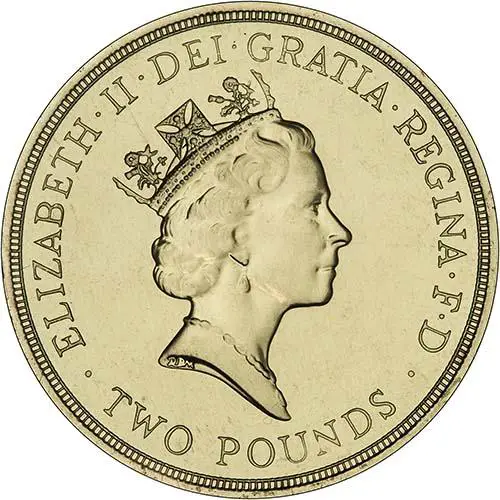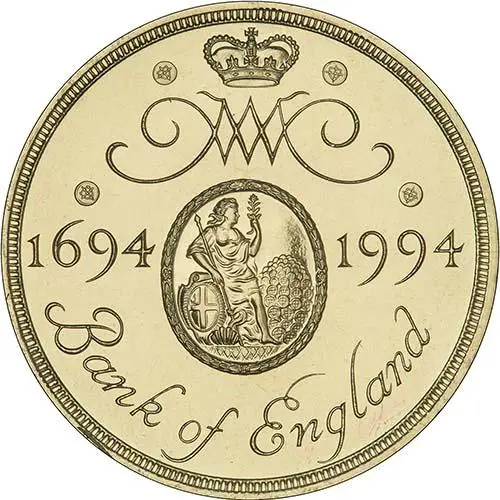The 1994 Bank of England £2 coin, often referred to as the 1694 to 1994 £2 coin, is an old-style £2 coin that has since been removed from circulation – but how much is it worth now?
You can expect to pay around £5.85 according to the most recent values in 2022 for the coin in circulated condition.
Let’s dive into the specification of the coin to determine whether it is actually rare and what makes it worth almost 3 times its face value to collectors.
Is The 1994 £2 Coin Rare?
The mintage for the 1994 Bank of England £2 coin was 1,443,116 for circulation. In terms of rarity, the coin is considered to be quite scarce as the mintage is quite low when compared to other £2 coins.
As with most commemorative coins, there were other versions issued by the Royal Mint and the mintage figures for these can be seen below:
| Version | Mintage | Estimated Value |
| Brilliant Uncirculated In Mint sets | N/A | £10-£20 |
| Silver Proof (0.925) | 27,957 | Around £20 |
| Silver Proof Piedfort (0.925) | 9,569 | Around £30-£50 |
| Gold Proof (22 carat) | 1,000 | Around £1,000 |
Bank of England £2 Error
The Royal Mint issued a 22-carat gold proof version, but the wrong obverse die was used.
There was an estimated total of between 50 and 300 out of the 1,000 gold proofs that were struck in error where the obverse die was that of the Double Sovereign.
On it, the Queen’s portrait is larger, and the legend is abbreviated like it is on the Sovereign coin, ELIZABETH * II D*G*REG*F*D. The value and denomination are not displayed. It is a Gold Proof mule with Double Sovereign obverse consisting of 0.917 Gold.
If you locate one of these mules, it is considered to be very rare and worth almost £2,000!
The coin was originally housed in a Royal Mint acrylic screw top capsule presented in a Royal Mint green leatherette case and accompanied by an individually numbered Certificate of Authenticity.
Other 1986-1996 £2 Coins
Between 1986 and 1996, the two pound coin was patterned after the gold Double Sovereign with the same weight and diameter.
The entire series of coins issued during this timeframe included 5 issue years with 7 different designs. All of them were commemorative coins intended to appeal mainly to collectors. These coins include:
-1994 Bank of England
–1995 50th Anniversary of the UN
–1996 Euro Football in England
Design 1694 to 1994 £2 Coin
The obverse of the 1994 two pound coin features the Raphael David Maklouf effigy which appeared on the obverse from 1985 to 1996. This is considered to be the third major portrait of Queen Elizabeth II.
She is facing the right wearing the royal diadem which she wears on her way to and from the State Opening of Parliament. She is also wearing a pearl necklace and earrings.
The incuse lettering on her neck truncation read RDM to indicate the designer, Raphael David Maklouf’s initials. Around the outside rim reads ELIZABETH * II * DEI * GRATIA * REGINA * F * D * TWO POUNDS. Translated from Latin, this means Elizabeth the Second, by the Grace of God, Queen, Defender of the Faith.
The edge of the coin is milled.
The edge inscription reads SIC VOS NON VOBIS which is the motto of William Paterson, who was an entrepreneur closely related to the establishment of the Bank of England.
The motto means thus we labour but not for ourselves. It originated from the words of Vergil, which another poet named Bathyllus plagiarized. William Paterson adopted it as his motto.
The reverse of the two pound round coin features a design by Leslie Durbin that was to commemorate the 300th anniversary of the establishment of the Bank of England.
In the centre is an image of the Corporate Seal of the Bank of England, which is the Britannia seated and holding a spear in her right hand resting on a shield carrying the cross of the flag of England and looking at a “Bank of Money”, and Cypher of William and Mary.
To the left and right of the image are the dates 1694 and 1994, which is where the often used name ‘1694 to 1994 £2 coin’ comes from.
Curved upward at the bottom and written in cursive banknote script are the words Bank of England. The entire image is crowned.
What Does The 1994 £2 Coin Represent?
The Tercentenary of the Bank of England two pound coin represents the 300th anniversary of the Bank of England.
When William and Mary came to the throne, the system of money and credit was in disarray with public finances weak. The Bank of England was founded in 1694 to act as the Government’s banker and debt manager.
The charter was sealed on July 27, 1694, at Powis House, Lincoln’s Inn Fields. The bank temporarily opened for business a few days later at the Mercers’ Hall in Cheapside. The first notes to bear the name Bank of England appeared shortly thereafter.
During the first half of the 17th century, banking in England was mostly done by goldsmiths who made extensive loans to the Crown. In 1672, the suspension of repayments by Charles II brought about a wave of bankruptcies and a demand for a public bank.
The young Scottish financier William Paterson backed by a powerful City group proposed the loan of more than one million pounds to the Government that was desperate for funding in the wake of war against France. In return, the subscribers would be incorporated as the Governor and Company of the Bank of England. The venture was supported by William III.
The money was raised in less than two weeks.
Where Can You Buy The Bank of England £2 Coin?
If you decide to purchase a Bank of England £2 – also known as the 1694 to 1994 £2 coin – then eBay is a good starting point for circulated versions – just make sure you use the guide price in this article to see whether you are getting a good deal or not.
For uncirculated versions, it is safer to browse dealerships to see if they have any of the proof or brilliant uncirculated versions in stock.

